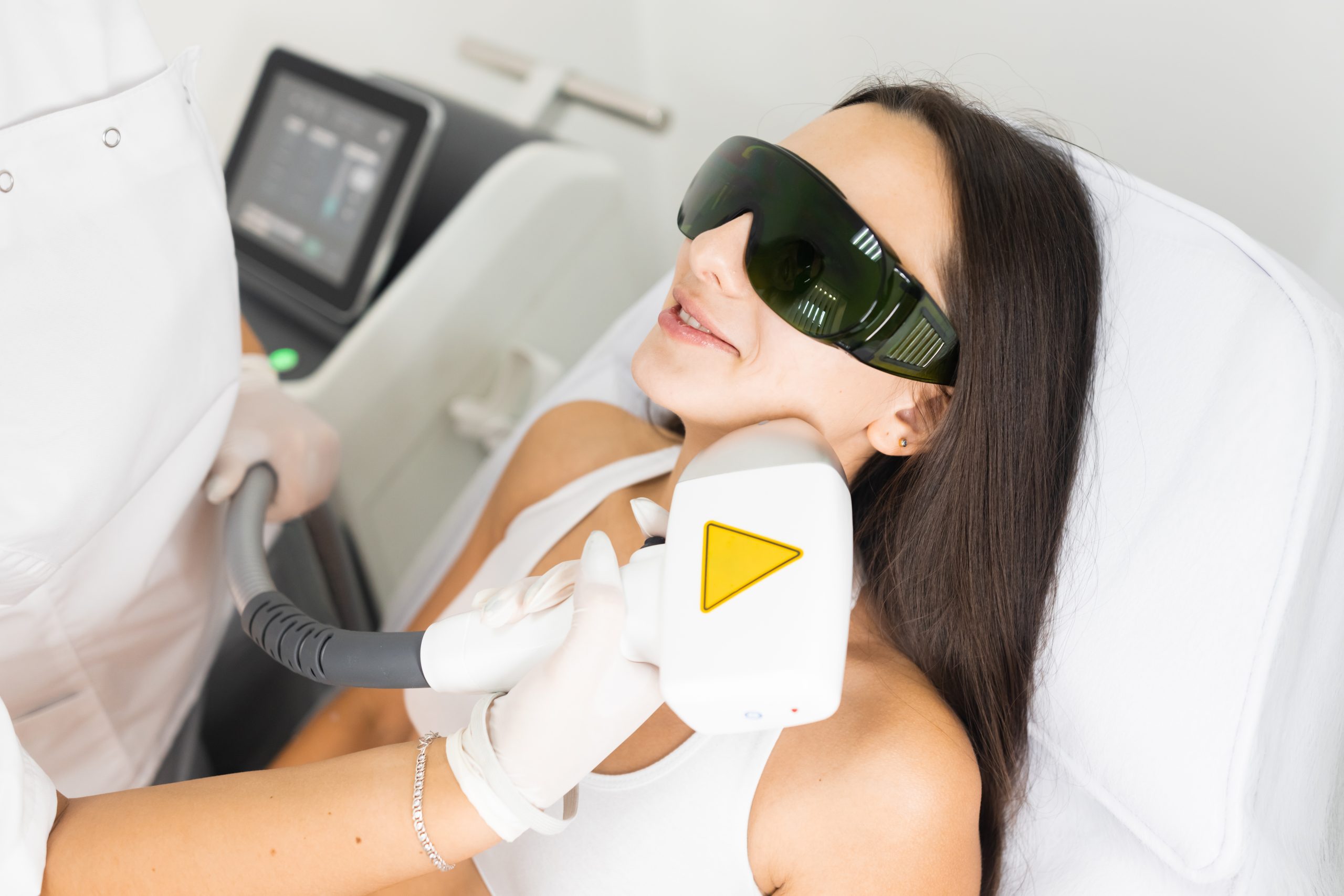Are melasma and post-inflammatory hyperpigmentation (PIH) making it hard for you to cover your skin? Don’t worry, lasers will save the day. Lasers are a safe and effective way for people of color to treat skin problems.
Melasma and PIH are both caused by having too much melanin in the skin, which makes the skin unevenly toned and dark spots. Traditional laser treatments have been used in the past, but pico laser technology has revolutionized the game. By delivering ultra-short pulses of laser energy, pico lasers target pigmented cells in the deeper layers of the skin without causing thermal damage to the surrounding skin cells.
The unique thing about pico lasers is that they can work on all skin kinds, even darker skin, which isn’t always possible with regular lasers. Pico laser pigmentation treatment can be changed to fit your skin state and worries because they have many options and treatment plans that can be changed.
With pico laser treatments, you can say goodbye to color problems that won’t go away and hello to a more even, glowing skin tone. Make up doesn’t have to hold you back; choose safe and effective laser options today!
What is Pico Laser?
The pico laser is a new tool that has changed the way laser treatments for skin problems are done. This high-tech laser system targets colored cells in the inner layers of the skin with very short laser bursts, protecting the surrounding skin cells from heat damage. The picosecond wave length of the pico laser breaks down pigment particles into smaller pieces that the body’s natural mending process can get rid of. The unique thing about the pico laser is that it can work on all skin types, even darker skin, which isn’t always possible with other lasers. Pico Laser’s flexible treatment plans and many settings make it a good choice for getting rid of skin problems like acne scars, age spots, and sun damage.
What is Pigmentation?
Pigmentation is the term for the color of the skin, which is mostly controlled by melanin production. Melanocytes, which are cells found in the surface of the skin, make melanin. These melanocytes make melanosomes, which are crystals that hold melanin and pigments.
Melanin production is controlled by many things, such as genes, hormones, and time spent in the sun. Many melanocytes can make too much melanin, which can cause coloring problems like melasma, dark spots, and uneven skin tone.
Some parts of the skin can get dark spots, which are also called hyperpigmentation, when they make too much melanin. This might happen because of the sun, changes in hormones, or your genes. When parts of your skin are lighter or darker than the rest of your skin, this is called uneven skin tone. This is usually caused by melanin being distributed unevenly.
Women are more likely than men to have melasma, a color problem that shows up as brown or dark spots on the face. Melasma can be caused by changes in hormones, like those that happen during pregnancy or hormone treatments.
There are many solutions for skin problems, such as the pico laser. Pico lasers work by sending very short bursts of laser energy to the skin, where they target and break down the pigment particles that cause color problems. This makes the skin tone more even and fades dark spots. It also makes melasma look better.
Benefits of Pico Laser for Pigmentation Treatment
For getting rid of stubborn coloring, the pico laser is a very good and new treatment choice. Pico laser can precisely target and break down the pigment particles that cause color problems by using very short bursts of laser energy. Some dark spots will go away, the skin tone will even out, and the look of melasma will get better. Pico lasers are better than regular lasers in a number of ways when it comes to treating color.
Accurate and focused treatment: The pico laser can treat skin problems in an accurate and focused way. It works by sending out picosecond-long bursts of laser energy that can be focused on the colored cells. This is a quick and easy way to treat age spots, dark spots, post-inflammatory hyperpigmentation, and other pigmented tumors, while doing little harm to the healthy skin around them.
Fits darker skin: The Pico laser is a good choice for people with darker skin who may be more likely to have coloring problems. Darker skin types may be more likely to get unwanted side effects from traditional laser coloring treatment because it can damage their skin with heat. The picosecond bursts of the pico laser, on the other hand, go deeper into the skin without doing much heat damage. This makes it a better and more effective choice for people with darker skin.
Results happen faster and treatment sessions are shorter: results happen faster with pico laser treatment than with traditional lasers. The ultra-short bursts of laser energy break down the pigment particles better, which makes the color fade faster. Pico laser treatments also need fewer sessions than other laser treatments, which cuts down on the total treatment time.
Minimal pain and recovery time: Pico laser treatments are pretty painless or barely painful. Some people may have slight heat or swelling after the treatment, but it generally goes away quickly. Pico laser treatments don’t need numbing creams or drugs like ablative laser treatments do. This makes the process easier and faster.
How Does a Pico Laser Work?
Pico Laser targets specific pigment particles in the skin with very short bursts of laser energy. Pico Laser is different from other lasers because it doesn’t use heat to break down extra melanin. Instead, it sends out picosecond bursts, which are a trillionth of a second long and have a photomechanical effect that breaks up pigment particles. This exact and focused method lets the laser go deeper into the skin, getting rid of dark spots, age spots, acne scars, and discoloration caused by inflammation a lot more effectively.
Pico Laser slowly gets rid of sun damage and brown spots by helping the skin’s natural repair process. Because of how different people’s skin reacts and how bad the coloring is, it may take more than one treatment session to get the best results. For a wide range of colored blemishes, the Pico Laser is an improved and effective option. It can be used on all skin types, even darker skin tones.
Traditional Lasers vs. Pico Lasers
Pigmentation has been treated with traditional lasers for a long time, but pico lasers are becoming more popular among patients. The biggest change is how the energy is sent. Pico lasers use very short pulses, usually in the picosecond range, while traditional lasers use beams that last longer. Because of this difference, colored cells can be targeted more precisely while good skin around them is damaged less.
When it comes to healing color, pico lasers are better than regular lasers in a number of ways. Pico lasers release energy more quickly because their bursts are shorter. This makes it easier to destroy pigment particles. This makes the loss of stubborn color go faster and better.
Pico lasers are also better for darker skin tones and more skin types because they are less likely to damage the skin with heat. People with darker skin are more likely to have bad side effects with standard lasers, like hyperpigmentation or hypopigmentation.
Pico lasers can target colored cells deeper in the skin without hurting the surrounding tissues because they use very short bursts. This makes it easier to get rid of colored spots and makes the skin tone more even.
The Science Behind the Treatment – How Does it Work?
Pico laser treatment uses cutting edge technology to successfully treat a number of skin problems. The ultra-short bursts of laser energy in this treatment are what make it work. They safely and effectively fade stubborn coloring.
The photoacoustic effect is an important part of Pico laser treatment. A very strong burst of energy is made when the laser beam hits the skin. The colored cells or particles in the skin take in this energy, which makes them move and break up. This photoacoustic effect makes it possible to destroy colored tumors and tattoos precisely without hurting the skin around them too much.
Pico lasers can get rid of colored tumors and scars, but they can also do other things. They are able to target only the colored cells and not the good skin around them. This level of accuracy makes treatment more successful and speeds up the healing process.
In addition, Pico lasers make the skin make more collagen. Collagen is an important protein that helps keep the skin’s suppleness and stiffness. Pico laser treatment not only fades color but also makes the skin look and feel better by increasing collagen production.
Different Types of Pigmented Lesions That Can Be Treated With a Pico Laser
Pigmented spots are a common skin problem that can happen to people of all ages and skin types. On the face, these growths can show up as age spots, dark spots, post-inflammatory hyperpigmentation, or other color changes. Sometimes, older laser treatments like q-switched lasers have been used to treat skin problems. But the arrival of pico lasers has completely changed the field. Pico lasers, like the PicoSure laser, target and destroy skin cells that are dark in color with very short bursts of laser energy. This technology is safe and works well for many different types of colored blemishes, such as acne scars, sun spots, solar lentigos, and more. Pico laser treatment is a game-changer for getting rid of stubborn pigmentation and making your skin look more even and younger because it can exactly target pigmentation and boost collagen production.
Melasma
Melasma is a common skin disease that makes patches of dark skin show up, mostly on the face. Mesopotamia comes in several forms, such as epidermal melasma, dermal melasma, and mixed melasma.
Epidermal melasma happens when the extra pigment is in the epidermis, which is the top layer of skin. With this kind of melasma, the spots are clear, light brown to dark brown, and more likely to get better with treatment.
For dermal melasma, on the other hand, the color is deeper in the skin, in the dermis. The spots that are caused by dermal melasma are usually bluish-gray or brownish, and their edges are not as clear. It can be harder to treat melasma on the skin, and you may need more treatment sessions.
Melasma that is mixed is made up of spots that have features of both epidermal and skin melasma. They can be any color from light brown to dark brown, and how well they respond to treatment varies.
There are many things that can lead to melasma, such as hormonal issues, UV exposure, some medicines, and a history of the problem in your family. Changes in hormones, like those that happen during pregnancy or while taking oral contraception, can cause melasma or make it worse.
Melasma can be hard to treat because it usually needs more than one method. Chemical peels, exfoliation, oral creams, and laser treatments are some of the options. Treatment works differently for different types of melasma and for different people.
Freckles
Small, flat, tan or light brown spots called freckles show up on the face. People with fair skin are more likely to get them, and they tend to show up on parts of the skin that get a lot of sun, like the face, arms, and shoulders. Freckles are safe and don’t pose any health risks, but some people may want to get rid of them for aesthetic reasons.
People with freckles have a few different choices for how to treat them. Lightening creams and treatments that you can buy over the counter, like hydroquinone or retinoids, can help freckles fade over time. A chemical peel, in which a chemical solution is put on the skin to remove the top layers, can also help make freckles look less noticeable. Laser treatments, especially pico laser treatments, have also been shown to help get rid of freckles and make skin tone better overall.
Pico laser is a brand-new tool that uses very short bursts of laser energy to treat skin problems. These short shocks work well to target and break down the extra pigmentation that makes freckles show up. The pico laser can easily go through the top layers of skin without hurting the tissues below. This means that people with all skin tones and types can use it.
When you get a pico laser treatment, the beam only hits the pigment particles that cause freckles, breaking them up and spreading them out. The body’s natural repair process then gets rid of these broken-up colors, which makes the freckles fade over time.
Lentigines (Age Spots)
Lentigines, which are also called age spots or liver spots, are dark, flat spots that show up on the skin when the body makes too much melanin. People who have been in the sun a lot or who have darker skin are more likely to get these colored spots. They tend to appear with age. Areas of the body that get a lot of sun, like the face, hands, shoulders, and arms, are more likely to get age spots.
Pico laser treatment has become a popular way to get rid of age spots. Very short bursts of laser energy are sent by this advanced laser technology directly to the skin’s colored cells. The laser energy breaks down the extra melanin, and the body’s natural recovery process gets rid of it over time. With pico laser treatment, the age spots can be precisely targeted without hurting the skin around them.
It is important to see a dermatologist to get a correct diagnosis of age spots and a personalized treatment plan. A dermatologist can look at the colored spots, figure out how bad they are, and suggest the best way to treat them. When it comes to getting the best results, pico laser treatment may be suggested along with other treatments like skin creams or sun protection.

Conclusion
In conclusion, Pico laser treatment can help fade discoloration in a number of ways. This non-invasive method uses exact bursts of laser energy to target the pigmented cells. This breaks down the extra melanin and lets the body’s natural recovery process get rid of it over time.
It is very important to talk to a doctor in order to find the best treatment plan for each person. They can look at how bad the colored spots are and come up with a personalized treatment plan that could include Pico laser treatment, skin creams, or other methods. Overall, Pico laser treatment looks like a good way to get rid of stubborn color because it is non-invasive, has little downtime, and works well.









